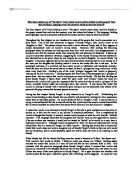Lord Of The Flies
How does Golding create the impression that the fire has a life of its own?
Golding uses many techniques to create the impression that the fire has a life of its own; in particular he uses similes, metaphors, animal imagery and personification. He compares the fire to creatures which would usually be found in the forest / jungle area.
A red squirrel is known for being vicious, fast, strong and having brightly coloured fur; in Golding’s description of the fire he uses a simile and a metaphor to describe the fire like a red squirrel. “Scrambled up like a bright squirrel,” the fire has a life of its own because like a squirrel it can ‘scramble’ up a tree and is of a bright vibrant colour. The metaphor, “The squirrel leapt on the wings of the wind and clung to another standing tree, eating downwards.” The fire is compared to a red squirrel that has similar characteristics to the fire, it moves swiftly through the air or from tree to tree, it is known for being vicious and this is shown by “eating downwards.”

This is a preview of the whole essay
Peer Reviews
Here's what a star student thought of this essay
Quality of writing
The Quality of Written Communication is very good. There are very few circumstances, if any, where errors in communication present a complication in the use of grammar, spelling or punctuation. I would recommend, as this candidate has most likely done, conducting a proof-read and spell-check before closing the exam booklet/the final coursework deadline because humans, naturally, makes mistake when writing and often miss them, and sometimes computerised spell-checkers do not pick up on these.
Level of analysis
The Level of Analysis is outwardly simple but very effective. Each paragraph deals with it's own linguistic technique or symbol that Golding has used, and there is suitable analysis of said technique, plus a recognition of how the audience responds to the use of similes, metaphors, animalistic imagery and personification. Coherent and valid analysis is present everywhere, with particularly the comments about the animalistic imagery carrying many of the marks due to the candidate looking beyond the page and interpreting the language used by Golding in their own way - this part of the essay feels a lot less prescriptive and is far more interesting to read.
Response to question
The candidate here provides a very good essay that relates very well to the question. There are very few 'spare words' here. Everything the candidate says is directly scoring marks, or at least working towards scoring marks. Each paragraph is nicely structured, dealing with various descriptions and depiction s of the fire in order to explain how Golding gives the fire "a life of it's own". The essay is very succinct and works well as a very lean, lit-crit essay which may come across as very sterile and slightly prescriptive, but it can, if done properly as seen here, give a candidate a grade as high as a B. To improve, candidates will be expected to variate a little more with their essays - perhaps provide a less regimented structure and/or concerning some ambiguity when interpreting the symbols (e.g. providing two possible analyses of one symbol) in order to vary the answer and make it that little more interesting a less stringently purpose-built.








